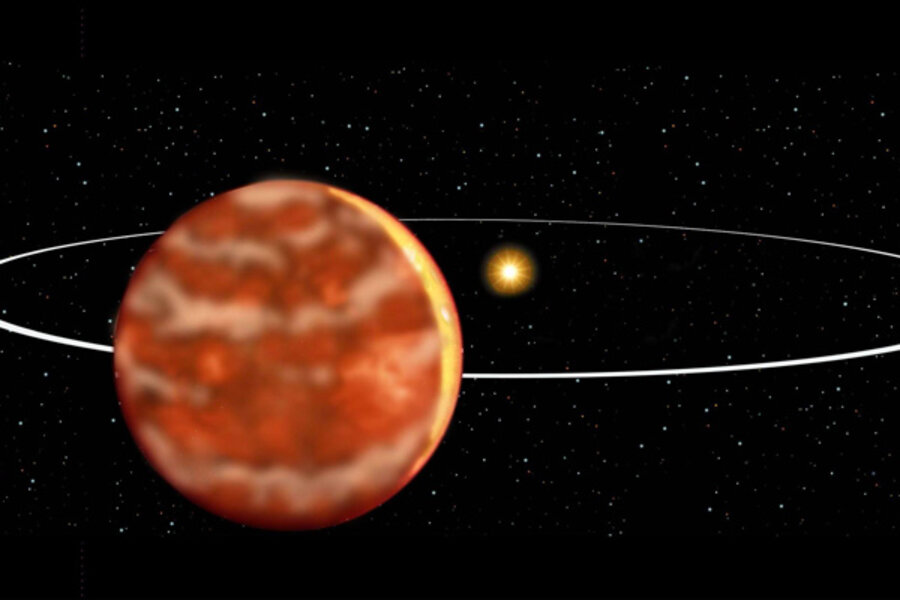Rare failed star found circling sun-like star
Loading...
A rare sun-like star that is both young and relatively close to Earth has been found to be harboring an even weirder object – a failed star locked in a close orbit around its host, according to a new study.
The newfound failed star, known as a brown dwarf, has been dubbed PZ Tel B. It is separated from its sun-like companion star PZ Tel A by a distance similar to that between Uranus and the sun in our solar system. [Photo of the brown dwarf.]
"Because PZ Tel A is a rare star being both close and very young, it had been imaged several times in the past," said research team member Laird Close, a University of Arizona professor at Steward Observatory. "So we were quite surprised to see a new companion around what was thought to be a single star."
An international team of astronomers, led by Beth Biller and Michael Liu of the University of Hawaii, made the rare find using the Near-Infrared Coronagraphic Imager (NICI), on the international 8-meter Gemini-South Telescope in Chile. The brown dwarf is about 36 times the mass of Jupiter, they found.
The host star PZ Tel A is essentially a younger version of the sun, but while it has a similar mass, it is much younger, at only 12 million years of age (about 400 times younger than the sun). The star is located approximately 168 light-years away from the sun.
The two objects are separated by only 18 astronomical units (AU). One astronomical unit is the average distance between the Earth and the sun, which is approximately 93 million miles (about 150 million km).
In the study, Close reanalyzed images of the parent star from 2003, in which the star's glare obscured the presence of the brown dwarf. That suggests its orbit is more elliptical, rather than circular, researchers said.
Why it's special
Brown dwarfs are odd objects that fall somewhere between planets and stars because of their temperature and mass. They are cooler and lighter than stars, but more massive – and typically hotter - than planets.
Most young brown dwarfs and their companions found by direct imaging are at orbital separations of greater than 50 AUs (about 4.6 billion miles). For comparison, Pluto's highly elliptical orbit ranges between 30 AU (2.7 billion miles) at its closest to 49 AU (4.5 billion miles) at its most distant, according to a NASA fact sheet.
So the relatively small 18 AU (1.6 billion miles) separation between the brown dwarf PZ Tel B and its partner is striking, researchers said. The astronomers also observed PZ Tel B moving quickly outward from its host star in a non-circular orbital path.
"PZ Tel B travels on a particularly eccentric orbit – in the last 10 years, we have literally watched it careen through its inner solar system," said Beth Biller, lead author of the study. "This can best be explained by a highly eccentric, or oval-shaped, orbit."
What this tells us
The PZ Tel system is young enough to still possess significant amounts of cold circumstellar dust, which may have been sculpted by the gravitational interaction with the young brown dwarf companion.
As such, the odd binary object system can serve as a laboratory that can help astronomers study the early stages of solar system formation, researchers said. The brown dwarf's mass and orbital motion have significant implications for what type of planets can form – if at all – in the PZ Tel star system.
Hunting brown dwarfs
The newfound brown dwarf was discovered using NICI, which is the most powerful high-contrast instrument designed for imaging brown dwarfs and alien planets around other stars. NICI is capable of detecting companions 1 million times fainter than the host star, at just one arcsecond separations.
Since the brown dwarf is so close to its parent star, special techniques were needed in order to distinguish the faint light of the companion from the light of the primary star. PZ Tel B is separated by 0.33 arcseconds – an angular measurement equal to 1/60 of a degree – from PZ Tel B. This is equivalent to a dime that is seen at a distance of 7 miles (11 km).
The research team was able to take pictures so close to the star by using an adaptive optics system and coronagraph to block our excess starlight. They then applied specialized analysis techniques to the images to detect PZ Tel B and measure its orbital motion.
An international team of researchers is currently carrying out a 300-star survey using NICI, which will be the largest high-contrast imaging survey conducted to date.
"We are just beginning to glean the many configurations of solar systems around stars like the sun," said Michael Liu, NICI campaign leader. "The unique capabilities of NICI provide us with a powerful tool for studying their constituents using direct imaging."
The details of the PZ Tel B discovery are described in a paper being published by the Astrophysical Journal Letters.
RELATED:





